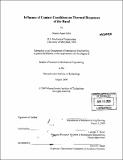| dc.contributor.advisor | Lynette A. Jones. | en_US |
| dc.contributor.author | Galie, Jessica Anne | en_US |
| dc.contributor.other | Massachusetts Institute of Technology. Dept. of Mechanical Engineering. | en_US |
| dc.date.accessioned | 2010-01-07T20:53:50Z | |
| dc.date.available | 2010-01-07T20:53:50Z | |
| dc.date.copyright | 2009 | en_US |
| dc.date.issued | 2009 | en_US |
| dc.identifier.uri | http://hdl.handle.net/1721.1/50564 | |
| dc.description | Thesis (S.M.)--Massachusetts Institute of Technology, Dept. of Mechanical Engineering, 2009. | en_US |
| dc.description | Includes bibliographical references (leaves 82-87). | en_US |
| dc.description.abstract | The objective of the research conducted for this thesis was to evaluate the influence of contact conditions on the thermal responses of the finger pad and their perceptual effects. A series of experiments investigated the thermal and perceptual effects of different contact conditions including contact force, contact duration, the object's surface temperature, and its surface roughness. The thermal response of the finger pad was measured using an infrared camera as the contact force varied from 0.1 to 6 N. It was determined that the decrease in skin temperature was highly dependent on the magnitude of contact force as well as contact duration. A second set of experiments investigated the effect of surface texture on the thermal response of the finger pad, and demonstrated, contrary to predictions, that a greater change in skin temperature occurs when the finger is in contact with rougher surfaces. The effect of varying surface texture on the perception of temperature was also investigated. The changes in temperature due to varying surface texture are perceptible, and demonstrate that the perception of surface roughness is not only influenced by changes in temperature, but in turn affects the perception of temperature. The final set of experiments examined the effect of varying the surface temperature of the thermal display on the perceived magnitude of finger force. Over the range of 20 to 38 'C, the surface temperature of the display did not have a significant effect on the perceived magnitude of force. The results of these experiments can be incorporated into thermal models that are used to create more realistic displays for virtual environments and teleoperated systems. | en_US |
| dc.description.statementofresponsibility | by Jessica Anne Galie. | en_US |
| dc.format.extent | 87 leaves | en_US |
| dc.language.iso | eng | en_US |
| dc.publisher | Massachusetts Institute of Technology | en_US |
| dc.rights | M.I.T. theses are protected by
copyright. They may be viewed from this source for any purpose, but
reproduction or distribution in any format is prohibited without written
permission. See provided URL for inquiries about permission. | en_US |
| dc.rights.uri | http://dspace.mit.edu/handle/1721.1/7582 | en_US |
| dc.subject | Mechanical Engineering. | en_US |
| dc.title | Influence of contact conditions on thermal responses of the hand | en_US |
| dc.type | Thesis | en_US |
| dc.description.degree | S.M. | en_US |
| dc.contributor.department | Massachusetts Institute of Technology. Department of Mechanical Engineering | |
| dc.identifier.oclc | 463643163 | en_US |
